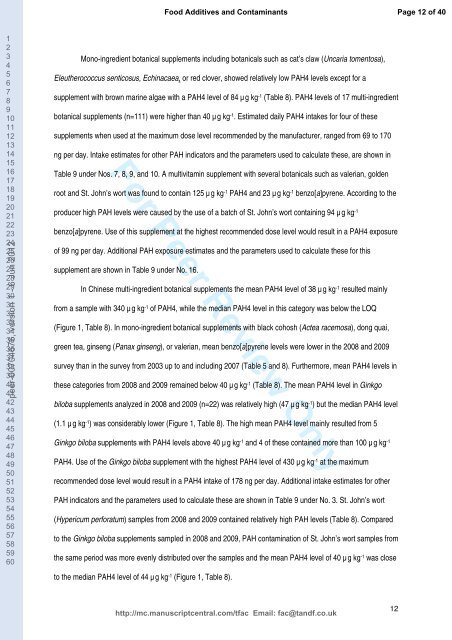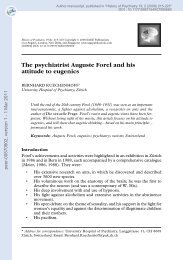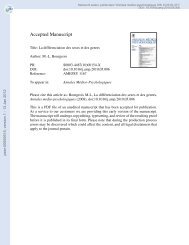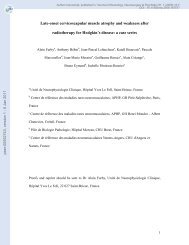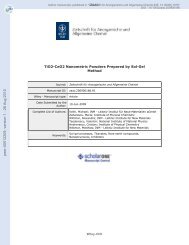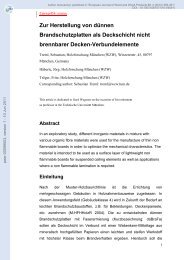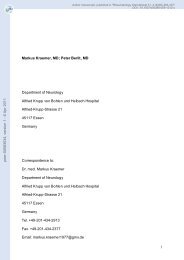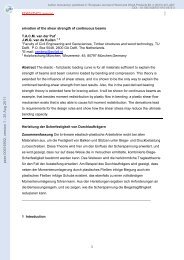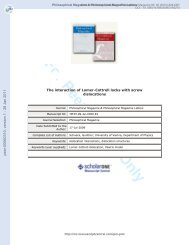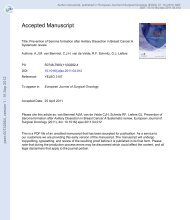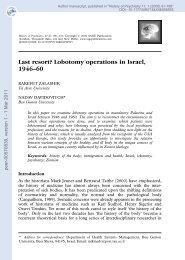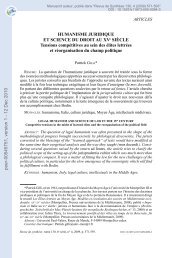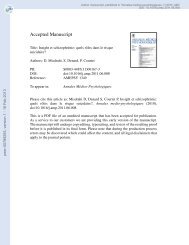Monitoring of Polycyclic Aromatic Hydrocarbons (PAH) in food ...
Monitoring of Polycyclic Aromatic Hydrocarbons (PAH) in food ...
Monitoring of Polycyclic Aromatic Hydrocarbons (PAH) in food ...
You also want an ePaper? Increase the reach of your titles
YUMPU automatically turns print PDFs into web optimized ePapers that Google loves.
1<br />
2<br />
3<br />
4<br />
5<br />
6<br />
7<br />
8<br />
9<br />
10<br />
11<br />
12<br />
13<br />
14<br />
15<br />
16<br />
17<br />
18<br />
19<br />
20<br />
21<br />
22<br />
23<br />
24<br />
25<br />
26<br />
27<br />
28<br />
29<br />
30<br />
31<br />
32<br />
33<br />
34<br />
35<br />
36<br />
37<br />
38<br />
39<br />
40<br />
peer-00704676, version 1 - 6 Jun 2012<br />
41<br />
42<br />
43<br />
44<br />
45<br />
46<br />
47<br />
48<br />
49<br />
50<br />
51<br />
52<br />
53<br />
54<br />
55<br />
56<br />
57<br />
58<br />
59<br />
60<br />
Mono-<strong>in</strong>gredient botanical supplements <strong>in</strong>clud<strong>in</strong>g botanicals such as cat’s claw (Uncaria tomentosa),<br />
Eleutherococcus senticosus, Ech<strong>in</strong>acaea, or red clover, showed relatively low <strong>PAH</strong>4 levels except for a<br />
supplement with brown mar<strong>in</strong>e algae with a <strong>PAH</strong>4 level <strong>of</strong> 84 µ g kg -1 (Table 8). <strong>PAH</strong>4 levels <strong>of</strong> 17 multi-<strong>in</strong>gredient<br />
botanical supplements (n=111) were higher than 40 µ g kg -1 . Estimated daily <strong>PAH</strong>4 <strong>in</strong>takes for four <strong>of</strong> these<br />
supplements when used at the maximum dose level recommended by the manufacturer, ranged from 69 to 170<br />
ng per day. Intake estimates for other <strong>PAH</strong> <strong>in</strong>dicators and the parameters used to calculate these, are shown <strong>in</strong><br />
For Peer Review Only<br />
Table 9 under Nos. 7, 8, 9, and 10. A multivitam<strong>in</strong> supplement with several botanicals such as valerian, golden<br />
root and St. John’s wort was found to conta<strong>in</strong> 125 µ g kg -1 <strong>PAH</strong>4 and 23 µ g kg -1 benzo[a]pyrene. Accord<strong>in</strong>g to the<br />
producer high <strong>PAH</strong> levels were caused by the use <strong>of</strong> a batch <strong>of</strong> St. John’s wort conta<strong>in</strong><strong>in</strong>g 94 µ g kg -1<br />
benzo[a]pyrene. Use <strong>of</strong> this supplement at the highest recommended dose level would result <strong>in</strong> a <strong>PAH</strong>4 exposure<br />
<strong>of</strong> 99 ng per day. Additional <strong>PAH</strong> exposure estimates and the parameters used to calculate these for this<br />
supplement are shown <strong>in</strong> Table 9 under No. 16.<br />
Food Additives and Contam<strong>in</strong>ants<br />
In Ch<strong>in</strong>ese multi-<strong>in</strong>gredient botanical supplements the mean <strong>PAH</strong>4 level <strong>of</strong> 38 µ g kg -1 resulted ma<strong>in</strong>ly<br />
from a sample with 340 µ g kg -1 <strong>of</strong> <strong>PAH</strong>4, while the median <strong>PAH</strong>4 level <strong>in</strong> this category was below the LOQ<br />
(Figure 1, Table 8). In mono-<strong>in</strong>gredient botanical supplements with black cohosh (Actea racemosa), dong quai,<br />
green tea, g<strong>in</strong>seng (Panax g<strong>in</strong>seng), or valerian, mean benzo[a]pyrene levels were lower <strong>in</strong> the 2008 and 2009<br />
survey than <strong>in</strong> the survey from 2003 up to and <strong>in</strong>clud<strong>in</strong>g 2007 (Table 5 and 8). Furthermore, mean <strong>PAH</strong>4 levels <strong>in</strong><br />
these categories from 2008 and 2009 rema<strong>in</strong>ed below 40 µ g kg -1 (Table 8). The mean <strong>PAH</strong>4 level <strong>in</strong> G<strong>in</strong>kgo<br />
biloba supplements analyzed <strong>in</strong> 2008 and 2009 (n=22) was relatively high (47 µ g kg -1 ) but the median <strong>PAH</strong>4 level<br />
(1.1 µ g kg -1 ) was considerably lower (Figure 1, Table 8). The high mean <strong>PAH</strong>4 level ma<strong>in</strong>ly resulted from 5<br />
G<strong>in</strong>kgo biloba supplements with <strong>PAH</strong>4 levels above 40 µ g kg -1 and 4 <strong>of</strong> these conta<strong>in</strong>ed more than 100 µ g kg -1<br />
<strong>PAH</strong>4. Use <strong>of</strong> the G<strong>in</strong>kgo biloba supplement with the highest <strong>PAH</strong>4 level <strong>of</strong> 430 µg kg -1 at the maximum<br />
recommended dose level would result <strong>in</strong> a <strong>PAH</strong>4 <strong>in</strong>take <strong>of</strong> 178 ng per day. Additional <strong>in</strong>take estimates for other<br />
<strong>PAH</strong> <strong>in</strong>dicators and the parameters used to calculate these are shown <strong>in</strong> Table 9 under No. 3. St. John’s wort<br />
(Hypericum perforatum) samples from 2008 and 2009 conta<strong>in</strong>ed relatively high <strong>PAH</strong> levels (Table 8). Compared<br />
to the G<strong>in</strong>kgo biloba supplements sampled <strong>in</strong> 2008 and 2009, <strong>PAH</strong> contam<strong>in</strong>ation <strong>of</strong> St. John’s wort samples from<br />
the same period was more evenly distributed over the samples and the mean <strong>PAH</strong>4 level <strong>of</strong> 40 µ g kg -1 was close<br />
to the median <strong>PAH</strong>4 level <strong>of</strong> 44 µ g kg -1 (Figure 1, Table 8).<br />
http://mc.manuscriptcentral.com/tfac Email: fac@tandf.co.uk<br />
12<br />
Page 12 <strong>of</strong> 40


